|
|
Montréal's St. Catherine Street Shopping
District
by Alan M.
Stewart
Until 1890, Montréal's major department
stores
were concentrated in a fashionable shopping district in Old
Montréal.
Within a decade, all but one had relocated to St. Catherine Street,
between Bleury
and de la Montagne. The move coincided with the transformation of space in
Montréal.
These grand and spacious stores, as well as their mail-order operations,
contributed
to a new type of shopping experience.
| |
 |
|
| |
 Plan
of downtown Montréal showing the main commercial artery, St.
Catherine
Street, and five department stores. Plan
of downtown Montréal showing the main commercial artery, St.
Catherine
Street, and five department stores.
|
|
| |
|
|
|
Carsley's, the First Mail-order
Catalogue
in Canada | Goodwin's Montreal Limited | From
Goodwin's to Eaton's | Scroggie's
|
Murphy's | Hamilton's and
Ogilvy's
| Conclusion | Further Reading
|
With a population of about 325 000 in 1901, Montréal was
Canada's
pre-eminent metropolis. As the city grew, the urban landscape was
transformed.
Although Old Montréal retained its role as the city's
business district
- enhanced by the construction of new office buildings - new
districts
came into being. Workers travelled greater distances between home and work
place.
Middle-class families moved to the suburban belt that surrounded the city
on
its western, northern and eastern flanks. Industrial suburbs emerged to
the southwest
and east.
| |
 |
|
| |
 View
of St. Catherine Street West, early 20th century. View
of St. Catherine Street West, early 20th century.
|
|
| |
|
|
|
The emergence of a distinctively retail axis along St. Catherine Street
illustrated
that the old-fashioned type of city with its mixture of residence and
workplace
and commerce, finance and industry - all accessible on foot -
was
gradually disappearing. The division of Montréal into separate
spaces
was not unique to Montréal, but the pattern here was quite
pronounced.
Moreover, mail order played an important role in the process.
| |
 |
|
| |
 Colonial
House, Henry Morgan & Co.'s uptown store, St. Catherine Street,
Montréal,
Quebec, ca 1893. Colonial
House, Henry Morgan & Co.'s uptown store, St. Catherine Street,
Montréal,
Quebec, ca 1893.
|
|
| |
|
|
|
With the opening of the Morgan's store on Philip's Square
in 1891,
the shift to St. Catherine Street signalled not only a separation of
"uptown"
retailing from "downtown" wholesaling and finance, but, for
most
firms, a significant increase in the scale of their activities. Although
the
transformation of St. Catherine Street into a major retail artery relied
on the
importance of a rapidly expanding local market, transactions with
out-of-town
customers by means of mail order boosted sales considerably.
Six major department stores dominated the retail landscape of
English-speaking
Montréal by 1895: Henry Morgan, S. Carsley, W. H. Scroggie, John
Murphy,
Henry and N. E. Hamilton, and James A. Ogilvy & Sons. Of these, the
first
three operated mail-order lines that endured for decades, even surviving
one
or more ownership changes in the case of Carsley's and
Scroggie's.
Murphy's transacted some out-of-town orders, but by 1905 had been
absorbed
by the Robert Simpson Company, which ran its own catalogue business from
Toronto.
|
Carsley's, the First Mail-order
Catalogue
in Canada
| |
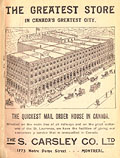 |
|
| |
 Carsley's
store on Notre Dame Street, at the turn of the century. S. Carsley,
Fall/Winter
Catalogue, No. 28, 1901-02, p. 2. Carsley's
store on Notre Dame Street, at the turn of the century. S. Carsley,
Fall/Winter
Catalogue, No. 28, 1901-02, p. 2.
|
|
| |
|
|
|
In 1871, Samuel Carsley established his dry goods store on the north
side
of Notre Dame Street, just west of Saint-Jean. Through successive
expansions
in the 1890s and early 1900s, the store ultimately occupied nearly the
whole
frontage of Notre Dame Street between Saint-Jean and Saint-Pierre, with an
extension
through to Saint-Jacques.
| |
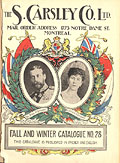 |
|
| |
 S.
Carsley, Fall/Winter Catalogue, No. 28, 1901-02, cover. S.
Carsley, Fall/Winter Catalogue, No. 28, 1901-02, cover.
|
|
| |
|
|
|
According to its 1899 catalogue, Carsley's pioneered catalogue
retailing
in Canada, issuing its first catalogue in 1882, two years before the T.
Eaton
Company of Toronto. By 1894, its "immense mail-order department
[was] one
of the wonders of the establishment," with hundreds of orders being
processed
daily. Parcels amounting to $5 or more in value were shipped prepaid to
any railroad
station within a radius of nearly 1000 kilometres [600 miles], while
single pairs
of kid gloves were sent post paid anywhere in Canada. Not many
Carsley's
catalogues are known to have survived.
| |
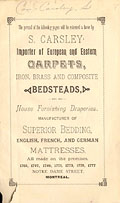 |
|
| |
 S.
Carsley Catalogue, 1885. S.
Carsley Catalogue, 1885.
|
|
| |
|
|
|
| |
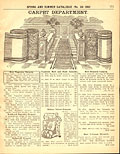 |
|
| |
 S.
Carsley Spring/Summer Catalogue, No. 30, 1902, p. 171. S.
Carsley Spring/Summer Catalogue, No. 30, 1902, p. 171.
|
|
| |
|
|
|
Issued in 1885, the first surviving catalogue - 23 pages in
length without
illustrations - bore a long title designed to draw the
reader's attention
to some of the store's home furnishings: "The perusal of the
following
pages will be esteemed a favour by S. Carsley, importer of European and
Eastern
carpets, Iron, Brass and Composite Bedsteads, and all House Furnishing
Draperies,
Manufacturer of Superior Bedding, English, French, and German
Mattresses."
The first six pages discussed how in recent years the quality of carpets
had
deteriorated by the introduction of jute - a defect not shared by
Carsley's
carpets - and advised customers to beware of the false economy of
purchasing
"low price carpets for the sake of saving a few cents a yard."
Advertising
copy made the case for buying floor cloths and linoleum, metal bedsteads,
wall
hangings, and reed furniture from Carsley's. Prices were indicated
for
selected goods, but seem to have been incidental to the larger sales
message
being conveyed.
The 1899 catalogue covered the entire store's spring and summer
goods.
Considerable effort was taken to educate customers about the desirability
of
making certain purchases. The pages devoted to each department typically
begin
with a paragraph explaining what was new and different and how the
assortment
offered by Carsley's was unequalled. Women were advised:
A well fitting corset is absolutely essential to a good form, without
the
aid of such, the most perfect figure must lose in contour and appearance.
Corset
buying with us has been made a study, keeping always in view the necessity
of
having the very best materials in substance, whilst at the same time
demanding
the necessary pliability and adaptability to ensure an easy pleasant fit.
(Carsley's
Spring/Summer Catalogue, 1899, p. 42)
Following the store's expansion and reorganization, some
departments
were better equipped to handle a larger range and volume of merchandise.
Carsley's
boasted:
The stock of wall papers now on hand is probably the largest in any
retail
store in Canada and comprises all the newest and best kinds, from the
ordinary
paper suitable for kitchens, etc., to the exquisite floral and gold
effects.
Buying wallpaper by sample through our mail order department is easy,
expeditious
and satisfactory. Write for samples, and you'll have them by return
of
mail. (Carsley's Spring/Summer Catalogue, 1899, p. 113)
Through these promotional texts, customers might learn about the
provenance
of quality goods, whether the best embroideries "made on the hand
looms
of St. Gall and Herizoff among the hills of Switzerland"; kid gloves
from
Grenoble, Paris, and Saint-Denis, France; china from Carlsbad, Haviland,
Dresden,
Doulton, Wedgwood, Copeland, and Winton; or handkerchiefs from the
handlooms
of Belgium. Information on the care of these items was occasionally
provided.
Buyers of Carsley's British-made hosiery were instructed that
"soap
should never be rubbed on fancy hosiery, use suds only, made of best
soaps, wash,
dry and iron on wrong side, all this should be done quickly."
| |
 |
|
| |
 Carsely's
after 1909 at its new location occupying part of the block on St. Catherine
Street between University and Victoria. Carsely's
after 1909 at its new location occupying part of the block on St. Catherine
Street between University and Victoria.
|
|
| |
|
|
|
In 1906, Carsley's, having delayed its move to St. Catherine
Street
for a full decade after other major department stores had left the
business district,
aggressively planned its entry uptown. By purchasing the property leased
by Scroggie's
department store, Carsley's acquired a prime location on St.
Catherine
between University and Victoria and forced one of its major competitors to
relocate.
Carsley's did not take possession of the premises until May 1909,
when
Scroggie's lease expired, but began buying properties behind the
store
in anticipation of an extensive building program.
|
Goodwin's Montreal Limited
| |
 |
|
| |
 Building
housing Goodwin's store, early 20th century. Building
housing Goodwin's store, early 20th century.
|
|
| |
|
|
|
Within five months of opening its new premises in May 1909,
Carsley's
sold its business to A. E. Rea & Company. The latter began
construction of
an extension that more than doubled the floor area. The store was known as
Rea's
until 1911 when, after W. H. Goodwin became managing director, it became
Goodwin's
Montreal Limited and then simply Goodwin's Limited.
| |
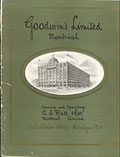 |
|
| |
 Goodwin's
Limited Fall/Winter Catalogue, No. 4, 1911-12, cover. Goodwin's
Limited Fall/Winter Catalogue, No. 4, 1911-12, cover.
|
|
| |
|
|
|
| |
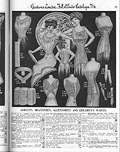 |
|
| |
 Women's
undergarments available at Goodwin's. Goodwin's Limited Fall/Winter
Catalogue,
No. 4, 1911-12, p. 39. Women's
undergarments available at Goodwin's. Goodwin's Limited Fall/Winter
Catalogue,
No. 4, 1911-12, p. 39.
|
|
| |
|
|
|
The only known surviving Goodwin's catalogue is the one issued
immediately
after the restructuring of the company, i.e., Fall/Winter 1911-1912.
As
a successor to Carsley's, Goodwin's inherited the mail-order
operation
but overhauled it. While Carsley's catalogue was printed in large
format
on cheap paper with simple illustrations, Goodwin's was smaller in
size
and communicated elegance, from the tasteful green cover featuring an
illustration
of the store through the 112 pages with their fine line drawings. A French
version
was also available.
Goodwin's advised customers that shopping by mail cost little
more while
guaranteeing satisfaction. It promised them the best goods at the lowest
prices,
delivered free to the nearest town. Claiming to be the only department
store
in Canada to do so, it confirmed that "ALL goods listed in our
catalogue
are delivered free to your nearest Railroad Station anywhere in
Canada."
For orders sent by mail and worth more than 50 cents Goodwin's
recommended
customers pay an additional two cents to guarantee safe delivery. In the
"event
of any dissatisfaction whatsoever," the store guaranteed to exchange
the
merchandise or refund the customer's money and return shipping
charges.
|
From Goodwin's to Eaton's
In 1925, the T. Eaton Company purchased the store and property. Over
the
next few years, Eaton's rebuilt the store, proceeding section by
section
so as to limit the disruption of business. When finished, the store stood
six
stories high; another three stories were added in 1930—31.
Eaton's
acquired Goodwin's to gain a foothold in Montréal and to
establish
distribution facilities for the largely French-speaking market of Quebec.
Eaton's
opened a mail-order showroom on Bleury and, three years later, a fully
automated
mail-order operation on Mont-Royal Avenue East. Intended to speed up
processing
and reduce costs, this new facility could not survive the rapidly
declining sales
during the early Depression and closed in 1931. Eaton's increased
its visibility
throughout Montréal and Quebec with the elegant store on St.
Catherine
Street and the French catalogue that was introduced in 1928.
|
Scroggie's
| |
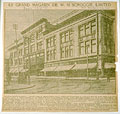 |
|
| |
 W.
H. Scroggie's store in 1905. W.
H. Scroggie's store in 1905.
|
|
| |
|
|
|
Although Morgan's was the first of the large department stores to
open
its doors on St. Catherine Street, William H. Scroggie had operated his
dry goods
store at the corner of St. Catherine and University since about 1885. In
fifteen
years, Scroggie expanded and transformed his business, creating a
department
store that occupied the Queen's Block between University and
Victoria.
By 1904, his store consisted of a four-storey central portion with
three-storey
wings.
When Scroggie's entered the mail-order business is unclear,
although
it may have been after the store's first expansion in 1892. By 1903,
it
carried on an "extensive mail order business ... throughout the
Dominion."
Two years later, it styled itself "The Mail Order House of Eastern
Canada,"
with the biggest business east of Ontario. Scroggie's mail-order
sales
pitch was all enthusiasm. Whether it was a question of how to send money
-
by express money order, postal note, or postal money order - or the
cheapest,
most reliable means of shipping goods (express was recommended for parcels
between
2 and 25 pounds and freight for goods over 25 pounds), Scroggie's
spring-and-summer
catalogue of 1905 provided the customer with necessary information.
Scroggie's policy translated into key selling points. In 1905,
the store
promised to fill orders the day they were received; it offered savings of
10
per cent to 20 per cent compared to other stores; and, for dry goods of $5
or
more and bulky merchandise of $10 or more, it paid freight charges to
railroad
stations within nearly 500 kilometres [300 mile] of Montréal. By
1910,
the promise of free delivery (with exceptions such as sugar, flour,
mattresses,
and appliances) extended throughout Canada on orders over $25.
Scroggie's
emphasized that shopping at its store was safe: With the exception of
millinery,
toiletries or cut fabric, it promised to refund the money on the return of
a
purchase. Every parcel was stamped with a "seal of
satisfaction."
Improved service soon extended to French customers. While the 1905
catalogue
told French clients that "nous préférons que vous nous
écrivez
en Anglais" [we prefer that you write to us in English], by 1908,
catalogues
were being issued in French. The company offered to send French catalogues
to
customers who had received English ones by mistake. In this regard
Scroggie's
was 20 years ahead of its Toronto-based competitors, Eaton's and
Simpson's.
For four years after Carsley's purchased the building in 1909,
Scroggie's
leased the cramped, two-story premises formerly occupied by
Hamilton's
at the southeast corner of St. Catherine and Peel. In November 1913,
having negotiated
a 19-and-a-half-year lease, Scroggie's moved into what was then the
city's
largest department store, a new, six-storey building on the south side of
St.
Catherine, between Bleury and Saint-Alexandre. In 1915, Scroggie's
sold
its operations to Almy's Limited, a company representing American
interests
from New York and Massachusetts. Almy's kept the business going,
with a
mail-order division occupying most of the sixth floor, until 1922 when it
ceased
activity.
|
Murphy's
In 1869, John Murphy established his dry goods store in a new
five-storey
remained and prospered at this location for a quarter century
notwithstanding
the competition from Samuel Carsley who, in 1871, opened his own
department store
next door. By 1890, Murphy's was active in mail order: "Orders
from
the country always receive our best attention and samples sent when
requested.
We keep a staff of hands who give their whole attention to letter
orders."
| |
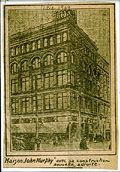 |
|
| |
 John
Murphy's store, St. Catherine Street, 1909. John
Murphy's store, St. Catherine Street, 1909.
|
|
| |
|
|
|
Squeezed by Carsley's and drawn by the opportunities in
Montréal's
Golden Square Mile, John Murphy & Company abandoned Old
Montréal for
St. Catherine Street, where it opened in a new five-storey building at the
corner
of Metcalfe in 1893. Presumably the mail-order division remained an
integral
part of the store. A year after the reorganization of Murphy's as a
limited
liability company in 1904, the Robert Simpson Company acquired a
controlling
interest, but continued to operate the store under the Murphy name. The
store
was extended in 1909-10 to occupy the western half of the block
between
Metcalfe and Mansfield Streets. In 1929, it was renamed Robert Simpson
Montreal
and all its assets were sold to Simpson's Limited, which demolished
the
building and built a new store covering the width of the block.
Simpson's
thus assumed a powerful presence on Montréal's premier
shopping
street.
|
Hamilton's and Ogilvy's
| |
 |
|
| |
 Hamilton's
store and view of St. Catherine's, looking west from Peel Street. Hamilton's
store and view of St. Catherine's, looking west from Peel Street.
|
|
| |
|
|
|
The remaining two department stores that moved their operations to St.
Catherine
were Hamilton's and Ogilvy's, neither of which was
significantly
involved in mail order. The origins of the dry goods business of Henry and
N.
E. Hamilton remain obscure, but, in 1891, the firm was sufficiently large
and
prosperous that it was able to take over the store vacated by Henry Morgan
&
Company on Victoria Square. After remaining there for five years,
Hamilton's
relocated to St. Catherine Street, where it occupied a new two-storey
building
on the southeast corner of Peel. In 1906, the department store made its
final
move, this time to the northwest corner of St. Catherine and Drummond
where,
as its business expanded, it gradually occupied the whole five-storey
building
by 1915. The firm last renewed its lease in 1925 and within two years
ceased
operation.
| |
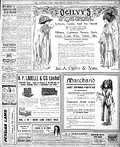 |
|
| |
 Ogilvy's
advertisement in the Montreal Daily Star, March 14, 1910. Ogilvy's
advertisement in the Montreal Daily Star, March 14, 1910.
|
|
| |
|
|
|
The history of Ogilvy's is unique, since it began neither in the
former
retail district in Old Montréal, nor on St. Catherine Street. The
store,
founded by James Ogilvy in 1866 on Saint-Antoine Street, occupied premises
at
the corner of Saint-Antoine and de la Montagne Streets, on the edge of the
uptown
district. In the 1880s, the character of the street changed dramatically
after
the Canadian Pacific Railway built its tracks on the escarpment between
Saint-Antoine
and the Dorchester terrace. In 1896, James Ogilvy & Sons moved to a
three-storey
building on the northeast corner of St. Catherine and de la Montagne.
Continued
growth made further expansion necessary and, rather than enlarge the
existing
building, in 1909-10, the firm built a new four-storey store, six
times
greater in area, across the street on the northwest corner of de la
Montagne.
A fifth storey was added in 1929.
|
Conclusion
For Montréal's English department stores, the turn of the
19th
century marked a period of significant growth and relocation. By 1910, all
the
major stores had left the business centre in Old Montréal and moved
to
St. Catherine Street. Although designed to serve the city market, these
stores
were, in at least four of the six cases, able to reach beyond the limits
of that
market by means of their mail-order businesses. The catalogue was both a
representation
of the store and an enticement to visit the store while in town.
| |
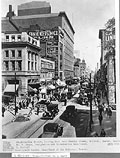 |
|
| |
 Busy
scene on the retailing artery of St. Catherine Street, looking east from
Stanley, 1930. Many of these buildings are still standing. Busy
scene on the retailing artery of St. Catherine Street, looking east from
Stanley, 1930. Many of these buildings are still standing.
|
|
| |
|
|
|
The harsher business climate of the 1920s brought business failures and
takeovers.
Only two of the original six stores - Morgan's and
Ogilvy's
- survived to 1930. Hamilton's disappeared entirely, while
Scroggie's
was reorganized by American interests as Almy's before succumbing as
well.
Murphy's retained its name but was purchased by Toronto-based
Simpson's
in 1905, while another Toronto giant, Eaton's, acquired
Goodwin's
in 1925. A strong French-Canadian competitor, Dupuis Frères,
emerged on
St. Catherine Street, east of the Main. Although in a class of its own,
Dupuis
was not entirely isolated from the English-speaking department-store
industry.
In 1910, the company recruited four of its managers from W. H.
Scroggie.
Notwithstanding these difficulties and consolidations, the surviving
department
stores physically expanded during the 1920s, relying on an enlarged local
and
regional market created by the newspaper, the telephone, the automobile,
and
the mail-order catalogue. The big stores and big names complemented one
another.
The result was the commercial artery and shopping habit of St. Catherine
Street
that attracted Montrealers and well-informed out-of-towners by the
thousand.
The street and its shops are still very much in vogue.
|
|
Further Reading
In addition to the books and magazines below, readers may consult store
catalogues.
The following can be found at McGill University Rare Books and Special
Collections:
S. Carsley and Company, Spring/Summer Catalogue, 1899; Goodwin's
Limited
Fall/Winter Catalogue, 1911-12; W. H. Scroggie Limited Spring/Summer
Catalogue,
1905. The McCord Museum of Canadian History holds the W. H. Scroggie
Limited
Spring/Summer Catalogue for 1908.
Book of Montreal: A Souvenir of Canada's Commercial
Metropolis.
Montréal: Book of Montreal Company, 1903.
Comeau, Michelle. "Les grands magasins de la rue Sainte-Catherine
à
Montréal: Des lieux de modernisation, d'homogénisation
et
de différenciation des modes de consommation. " In
Material
History Review/Revue d'histoire de la culture matérielle
(41)(Spring
1995): 58-68.
Communauté urbaine de Montréal. Répertoire
d'architecture
traditionnelle sur le territoire de la communauté urbaine de
Montréal.
Les magasins, les cinémas. Montréal: CUM, Service de la
planification
du territoire, 1985.
Montreal Illustrated, 1894. Montréal: Consolidated
Illustrating
Company, 1894.
Souvenir Number of the Montreal Daily Star, Reviewing
Various
Financial and Commercial Interests Represented in the City of
Montreal.
[Montréal]: Henning and Camp, [1890].
Special Number of the Dominion Illustrated Devoted to Montreal,
the Commercial
Metropolis of Canada. Montréal: Sabiston Lithographic and
Publishing
Company, 1891.
Whitefield, Edwin. Topographical Business Directory, Montreal,
C.E. Montréal:
E. Whitefield, 1864.
|
| |
|
|